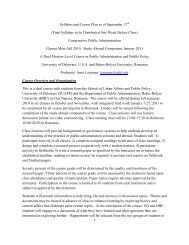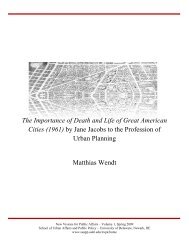New Visions for Public Affairs Volume 1 - School of Public Policy ...
New Visions for Public Affairs Volume 1 - School of Public Policy ...
New Visions for Public Affairs Volume 1 - School of Public Policy ...
You also want an ePaper? Increase the reach of your titles
YUMPU automatically turns print PDFs into web optimized ePapers that Google loves.
Wendt, Matthias Death and Life by Jane Jacobs 20<br />
increased street safety. The proposed number <strong>of</strong><br />
af<strong>for</strong>dable housing units adds to the project’s overall<br />
heterogeneity and may create the kind <strong>of</strong> diversity<br />
Jacobs intended (Jacobs, 1961). On the other hand,<br />
Jacobs herself points out that “large swathes <strong>of</strong><br />
construction built at one time are inherently inefficient<br />
<strong>for</strong> sheltering wide ranges <strong>of</strong> cultural, population and<br />
business diversity” (Jacobs, 1961, p.191). Hence, she<br />
would have certainly opposed Atlantic Yards being<br />
built by one developer and one architect, being reserved<br />
<strong>for</strong> upscale uses and retail and not providing space <strong>for</strong><br />
low-rent uses.<br />
The key feature <strong>of</strong> Atlantic Yards is that it is<br />
constructed atop the Vanderbilt Rail Yard that currently<br />
bisects the neighborhoods <strong>of</strong> Fort Greene and Prospect<br />
Heights. It remains questionable if Atlantic Yards will<br />
be able to close the current border vacuum created by<br />
the rail yard. The permeability <strong>of</strong> the project will be the<br />
determining factor – whether the new development will<br />
be able to knit together these two neighborhoods.<br />
Furthermore, it will be critical to see whether the<br />
proposed gardens on the inside <strong>of</strong> the project feel like a<br />
smooth extension <strong>of</strong> the public realm or whether they<br />
will be isolated from the street grid. As the project<br />
provides ground-floor retail uses and cafés and<br />
restaurants on its perimeters, it follows Jacobs’<br />
recommendation to turn borders into seams that become<br />
“a line <strong>of</strong> exchange along which two areas are sewn<br />
together” (Jacobs, 1961, p.267).<br />
Applying Jacobs’ conditions <strong>for</strong> diversity in cities (see<br />
section V) to the Atlantic Yards, the project would meet<br />
the conditions <strong>of</strong> several primary functions and dense<br />
concentration <strong>of</strong> people. However, Jacobs saw the<br />
danger posed by densities higher than Boston’s North<br />
End’s 275 dwellings per acre and drastic<br />
standardization <strong>of</strong> building types (Jacobs, 1961). The<br />
Atlantic Yards Project, with 292 dwellings per acre,<br />
would be significantly denser, made possible through<br />
higher buildings and high rates <strong>of</strong> standardization.<br />
However, the remaining two Jacobsian qualities,<br />
frequent streets and varied buildings, would be absent<br />
from the Atlantic Yards plan. It would create two<br />
superblocks – one <strong>for</strong> the basketball arena and another<br />
<strong>for</strong> the second phase, bounded by Carlton and<br />
Vanderbilt avenues and Pacific and Dean Streets.<br />
The biggest drawback <strong>of</strong> the Atlantic Yards Project is<br />
the involvement <strong>of</strong> eminent domain that Jacobs<br />
criticized, as it can have drastic and <strong>of</strong>ten ruinous<br />
consequences <strong>for</strong> commercial tenants and residents <strong>of</strong><br />
the condemned property (Jacobs, 1961). In 2007,<br />
residents and business owners who had previously<br />
refused to sell their properties to the development<br />
corporation filed a suit because <strong>of</strong> the looming<br />
condemnation <strong>of</strong> their businesses and homes. The<br />
plaintiffs argued that the primary benefit <strong>of</strong> the project<br />
would be private and would enrich the developer,<br />
Forest City Ratner Companies. They further contended<br />
that the project was initiated by the developer rather<br />
than the city or state <strong>of</strong>ficials (Confessore, 2007).<br />
In determining that the plaintiffs’ claims lacked merit,<br />
the United States District Court in Brooklyn found that<br />
the plaintiffs had not presented facts supporting the<br />
<strong>New</strong> <strong>Visions</strong> <strong>for</strong> <strong>Public</strong> <strong>Affairs</strong> – <strong>Volume</strong> 1, Spring 2009<br />
<strong>School</strong> <strong>of</strong> Urban <strong>Affairs</strong> and <strong>Public</strong> <strong>Policy</strong> – University <strong>of</strong> Delaware, <strong>New</strong>ark, DE<br />
www.suapp.udel.edu/nvpa/home







